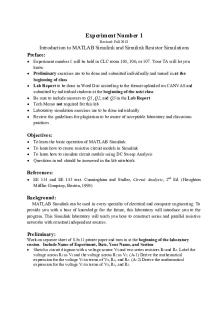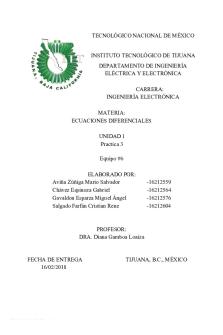MATLAB Simulink PDF

| Title | MATLAB Simulink |
|---|---|
| Course | Control Systems |
| Institution | COMSATS University Islamabad |
| Pages | 11 |
| File Size | 549.6 KB |
| File Type | |
| Total Downloads | 92 |
| Total Views | 169 |
Summary
Here we have a lab work on MATLAB Simulink....
Description
COMSATS University Islamabad, Wah Campus Electrical & Computer Engineering Department Lab Rubrics Evaluation sheet Spring 2020
Program: BEE
Section: 6D
Subject: Power Electronics
Reg #: FA17-BEE-
Lab No: 01
Name: MUHAMMAD
Lab Instructor: Engr.Adnan Saleem Mughal
Date: 9/08/2020
___________________________________________________________________________________ Title of experiment: Familiarization with MATLAB window Environment ________________________________________________________________
Rubrics Evaluation:
Performance indicator
Maximum Marks
Execution / Implementation
5
Team Work
5
Lab Report
5
Total
15
Rubrics Evaluated By: ______________ Date:
Obtained Marks
Rubrics Evaluation Verified By: ______________
______________
Date: _________________
__________________________________________________________________________________ Excellent: 5
Very Good: 4
Good: 3
Satisfactory: 2
Poor: 1
Objective: Objective is to learn basics of MATLAB
Equipment: MATLAB
Introduction: In this lab we have learnt how to implement basic formulas and identities in Matlab.
Tasks:
Activity# 01: i)
Use arbitrary value of theta and verify that sin^2(theta)+cos^2(theta)=1
clc; clear; close all; theata=45; theata1=45*(180/pi); x=(sin(theata1)*sin(theata1)+cos(theata1)*cos(theata1))
clc; clear; close all; theata=30;
theata1=(2/180)*pi; z=sinh(theata1) y=(exp(theata1*j)-exp(-theata1*j))/2*j
clc; clear; close all; theata1=(45/180)*pi; z=tan(theata1) y=(sqrt(1-cos(2*theata1)/(1+cos(2*theata1))))
clc; clear; close all; t=input('enter value of t') y=exp(-0.2*t)*(cos(t)+j*sin(t))
ACTIVITY# 02
clc; clear; close all; z=3+j*4 j=4;
a=3+4j b=3+4*j c=3+j*4
clc; clear; close all; w=10*pi; T=0.1; G=1+j*w*T; V=1/(1+j*w*T); A=abs(G) B=phase(G) C=abs(V) D=phase(V)
clc; clear; close all; w=2*pi; G=1-j*w/j*w*(1+j*2*w); A=abs(G) B=phase(G)
ACTIVITY #03
clc; clear; close all; x=-1:1:1 y=1+exp(-x)/1-exp(-x)
clc; clear; close all; t=-1:1:1 y=2*exp(-t)-3*exp(-2*t)
ACTIVITY#04:
clc; clear; close all; A=[2 5 -3;3 -2 4;1 6 -4]; b=[6;-2;3]; x=inv(A)*b
clc; clear; close all; t=1:1:10; T=2; k=0.75; w=k*(1-exp(-t/T))
i.
clc; clear; close all; t=0:0.05:5; y=(exp(-t)).*(sin(pi*t))
ii.
clc; clear; close all; t=0:0.05:5; y=(sin(pi.*t.*t))/(t.*t)
PLOTING:
clc; clear; close all; t=linspace(0,10,50); T=2;k=0.75; w=k.*(1-exp(-t/T)); subplot(3,1,1) plot(t,w) k=3; w=k.*(1-exp(-t/T)); subplot(3,1,2) plot(t,w) k=5; w=k.*(1-exp(-t/T)); subplot(3,1,3) plot(t,w)
clc; clear; close all; t=linspace(0,10,50); k=3;T=2; w=k.*(1-exp(-t/T)); subplot(3,1,1) plot(t,w) T=0.5; w=k.*(1-exp(-t/T)); subplot(3,1,2) plot(t,w)
T=4; w=k.*(1-exp(-t/T)); subplot(3,1,3) plot(t,w)...
Similar Free PDFs

MATLAB Simulink
- 11 Pages
Popular Institutions
- Tinajero National High School - Annex
- Politeknik Caltex Riau
- Yokohama City University
- SGT University
- University of Al-Qadisiyah
- Divine Word College of Vigan
- Techniek College Rotterdam
- Universidade de Santiago
- Universiti Teknologi MARA Cawangan Johor Kampus Pasir Gudang
- Poltekkes Kemenkes Yogyakarta
- Baguio City National High School
- Colegio san marcos
- preparatoria uno
- Centro de Bachillerato Tecnológico Industrial y de Servicios No. 107
- Dalian Maritime University
- Quang Trung Secondary School
- Colegio Tecnológico en Informática
- Corporación Regional de Educación Superior
- Grupo CEDVA
- Dar Al Uloom University
- Centro de Estudios Preuniversitarios de la Universidad Nacional de Ingeniería
- 上智大学
- Aakash International School, Nuna Majara
- San Felipe Neri Catholic School
- Kang Chiao International School - New Taipei City
- Misamis Occidental National High School
- Institución Educativa Escuela Normal Juan Ladrilleros
- Kolehiyo ng Pantukan
- Batanes State College
- Instituto Continental
- Sekolah Menengah Kejuruan Kesehatan Kaltara (Tarakan)
- Colegio de La Inmaculada Concepcion - Cebu














